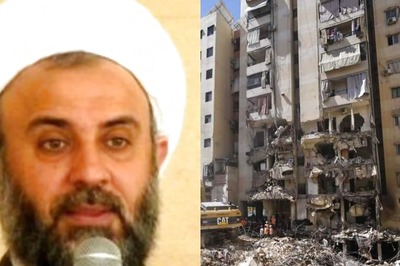
views
The memorial of warrior king Chhatrapati Shivaji Maharaj has been proposed in the Arabian Sea off Mumbai’s west coast. The waters on this seaboard often get choppy, raising questions about access via boats to the site located off the iconic Girgaum Chowpatty in south Mumbai. However, the state government is planning the construction of an undersea tunnel, which will connect the shore to the memorial during bad or inclement weather.
This is expected to escalate the cost of the memorial — which is already in the limelight for the likely impact on environment — from the present Rs 3,600 crore. The memorial will have a 212-metre-high equestrian statue of the 17th century warrior king whose regime is lauded for its religious tolerance, respect for women and welfare measures.
Not content with these plans, the hard-line pro-Maratha Sambhaji Brigade has demanded that the memorial not be constructed in the sea, considering its high maintenance costs and concerns about access, but on land. The outfit has proposed the Raj Bhawan in Mumbai as one of the alternate sites.
A few kilometres away from the location of this proposed memorial lies the gleaming Bandra Worli sea link (BWSL), once hailed by a former chief secretary of Maharashtra as the city’s only post-Independence “signature piece of architecture”. The thousands of motorists who use the around 6km cable-stayed bridge may be unaware that they are crossing three forts at Bandra, Mahim and Sewri, which have a history dating to the colonial and pre-colonial era.
While the state government promises to boost tourism, these forts do not form part of the itinerary of most domestic and international tourists in Mumbai. They also lack holistic development and conservation.
Similarly, the Maharashtra state archives, located in the premises of the historic Elphinstone College in South Mumbai, also suffers from a lack of funding. The directorate holds around 15 crore historic papers in its repositories located in Mumbai, Pune, Aurangabad, Nagpur and Kolhapur, of which the oldest is a Nizamshahi-era document dating to the 14th century. But lack of strategic vision and funding have ensured that the directorate has been able to digitise just around 4.5 crore of them in a decade.
While successive state governments plan memorials with costs running into crores for Shivaji Maharaj, Dr Babasaheb Ambedkar (Rs 1,089.95 crore) and late Shiv Sena chief Bal Thackeray (Rs 100 crore), Maharashtra’s forts and archaeological sites, which have a rich historic value, languish due to lack of funds and conservation. For instance, the forts in Mumbai like those at Sewri, Mahim, and Dharavi, which are being taken over by vandals, slumlords and encroachers, and are crumbling due to lack of protection and care.
Sample this: Ter, a village located around 450km from Mumbai, has a rich archaeological heritage and conducted trade with the ancient Roman empire around 2,000 years ago. Ter, or Tagar as it was called in ancient times, was populated during the pre-Satavahana, Satavahana, late-Satavahana, and Vakataka periods, and was a part of ancient trade routes. Excavations at the site have yielded evidence that khichdi, the comfort food of many Indians, may have been cooked at Ter around 2,000 years ago. A replica of an ivory doll found at Ter is also exhibited at Pompeii in Italy, indicating that it may have made its way there from ancient India.
However, despite this archaeological and historic significance, Ter continues to languish due to lack of conservation and protection. The village had 10 ancient mounds with archaeological remains underneath. But of these, three have been destroyed by people who mine the sand for use as fertiliser and for baking bricks, and the others face a similar existential crisis. Of the seven mounds that remain, archaeological excavations have been conducted at just three. Archaeologists lament that the sites are raided for remains like beads, terracotta figurines and other artefacts by bounty hunters. These mounds are also used for open defecation.
Maharashtra also has around 355 forts of which just 100 have been granted protected status by the Archaeological Survey of India (ASI) and the state directorate of archaeology and museums. Officials from the state directorate admit that they have less than 100 watchmen and site staff to protect and man 371 monuments, including 49 forts, 153 medieval-era temples, 20 caves and other features. The department also lacks funds for conservation of these monuments.
Worse, the funds and schemes promised by the state government fail to make the transition from the drawing board to reality. For instance, in 2018, the state budget promised to grant Rs 24 crore for conservation and protection of the over 10,000-year-old petroglyphs on the Konkan coastline. However, the directorate of museums and archaeology is yet to get the funds for the project, with proposals sent to the state for protecting these rock-cut reliefs carved into the laterite rocks on the ground yet to see the light of the day. These pre-historic carvings date to the late Stone Age and are estimated to have been carved out between 10,000 BC and 2,000 BC.
The irony is stark. The hill forts in the Sahyadri, which served Shivaji Maharaj well when he fought to marauding forces of Adilshah and Mughals and are hence his living monuments, are crumbling even as a memorial to the Chhatrapati takes shape in Mumbai.
So, is this a case of misplaced priorities? Despite facing a severe fund crunch, is the state directing its scarce resources towards the politics of totems?
Yes, admit most policymakers and politicians. For it is high-optic brick-and-mortar projects centered on icons that serve the cause for mass mobilisation, especially those linked to caste, religion and identity.
Of course, on the sidelines of these plans, there are reports that the Comptroller and Auditor General (CAG), which audited the Shivaji Maharaj memorial project, pointed out that the change in the scope of the work led to the project management consultant (PMC) getting an “undue benefit” of Rs 9.61 crore.
The state government wants the memorial to be the tallest statue in the world, four meters higher than the Spring Temple Buddha in China’s Henan province. The cabinet has also approved an increase in the height of Dr Ambedkar’s ‘Statue of Equality’ to be built at Dadar by another 100 feet to 450 feet.
To summarise the Greek philosopher Plato, for a perfect, utopian society to come into existence, philosophers must become kings, or kings must philosophise. Until then, reason can always be sacrificed at the altar of politics…
(Dhaval Kulkarni is a Mumbai-based journalist and author of ‘The Cousins Thackeray: Uddhav, Raj and the Shadow of their Senas’. Views expressed are personal)




















Comments
0 comment